
Providential Examples in History - First Millennium

“History may be said to be the summation of the actions of man in time. Miracles are God’s sovereign interventions into our three dimensional world, in which this historical process has been, ever since the creation of man, realizing itself. History has a destination, even if we cannot discern it at once, and God is working in history even if his ways are difficult or impossible to recognize. But since history consists of the acts of man and miracles are the acts of God, it may be asked how the two can be brought together, and, how it is possible to probe the influence that miracles have had on the historical process of mankind. …”
— Zsolt Aradi (1908-1968) Hungarian Author and Historian
First Millennium - First 500 years
The Shroud of Turin - 0 AD

The Shroud is a linen cloth with a herringbone weave of a type that was in use among the Essenes during the 1st century. It measures exactly 2 cubits (.91 meter) (3 ft 7 in) by 8 cubits (3.66 meters) (14 ft, 3 inches). Such cloths were used as a burial cloth. The Shroud contains a negative image of a man crucified according to Roman custom but who was separately scourged over his entire body and was crowned with thorns. The man is just under 6 ft. (1.8 m) tall, very tall in an age where the average man was under 5’ 6” (1.68 m). The man weighed about 185 lbs. (84 kg). The man has long hair pulled back into a pony tail and a long beard. The long hair and beard could denote a Nasserite as it was the custom of Israelites under a Nasserite vow to neither cut their hair nor trim their beard. The individual on the Shroud has been identified as of Semitic origin. He has been crucified according to Roman custom; however, he has also worn a crown of thorns and has endured a separate scourging over his entire body below his neck. A full body scourging is usually fatal. There are no other documented cases where an individual has endured both a full body scourging, a crucifixion, as well as a crowning with thorns (The signature of Jesus the Nazarene). He has also experienced a stab wound on the right side between the 5th and 6th rib that occurred after death. … The shroud is the most studied historical artifact in the world. The image is a negative. (from website the Mystics of the Church)
The Sudarium of Oviedo - 0 AD
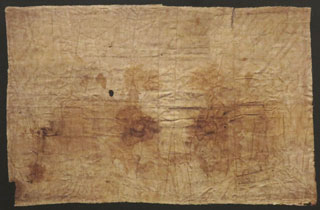
The Sudarium is a 33” x 21” handkerchief used to cover the face of criminal immediately after death. This was allowed by the Romans because upon death the criminals debt was considered paid and the family need suffer no more from the shame of having a family member as a criminal that was crucified naked.
The Sudarium was the “other cloth” that was lying folded in the corner of the tomb when Peter and John entered the tomb. (from the website Mysteries of the Rosary)
Anne Catherine Emmerich’s Vision - The Nailing of Jesus to the Cross – (For the Readers Discernment) from - 0 AD
THE preparations for the crucifixion being finished four archers went to the cave where they had confined our Lord and dragged him out with their usual brutality, while the mob looked on and made use of insulting language, and the Roman soldiers regarded all with indifference, and thought of nothing but maintaining order. When Jesus was again brought forth, the holy women gave a man some money, and begged him to pay the archers anything they might demand if they would allow Jesus to drink the wine which Veronica had prepared; but the cruel executioners, instead of giving it to Jesus, drank it themselves. They had brought two vases with them, one of which contained vinegar and gall, and the other a mixture which looked like wine mixed with myrrh and absinthe; they offered a glass of the latter to our Lord, which he tasted, but would not drink.
There were eighteen archers on the platform; the six who had scourged Jesus, the four who had conducted him to Calvary, the two who held the ropes which supported the cross, and six others who came for the purpose of crucifying him. They were strangers in the pay of either the Jews or the Romans, and were short thick-set men, with most ferocious countenances, rather resembling wild beasts than human beings, and employing themselves alternately in drinking and in making preparations for the crucifixion.
This scene was rendered the more frightful to me by the sight of demons, who were invisible to others, and I saw large bodies of evil spirits under the forms of toads, serpents, sharp-clawed dragons, and venomous insects, urging these wicked men to still greater cruelty, and perfectly darkening the air. They crept into the mouths and into the hearts of the assistants, sat upon their shoulders, filled their minds with wicked images, and incited them to revile and insult our Lord with still greater brutality.
Devotion to Our Lady of Sorrows – Our Lady’s Blue Army Weeping angels, however, stood around Jesus, and the sight of their tears consoled me not a little, and they were accompanied by little angels of glory, whose heads alone I saw. There were likewise angels of pity and angels of consolation among them; the latter frequently approached the Blessed Virgin and the rest of the pious persons who were assembled there, and whispered words of comfort which enabled them to bear up with firmness.
The executioners soon pulled off our Lord’s cloak, the belt to which the ropes were fastened, and his own belt, when they found it was impossible to drag the woollen garment which his Mother had woven for him over his head, on account of the crown of thorns; they tore off this most painful crown, thus reopening every wound, and seizing the garment, tore it mercilessly over his bleeding and wounded head. Our dear Lord and Saviour then stood before his cruel enemies, stripped of all save the short scapular which was on his shoulders, and the linen which girded his loins. His scapular was of wool; the wool had stuck to the wounds, and indescribable was the agony of pain he suffered when they pulled it roughly off.
He Shook like the aspen as he stood before them, for he was so weakened from suffering and loss of blood that he could not support himself for more than a few moments; he was covered with open wounds, and his shoulders and back were torn to the bone by the dreadful scourging he had endured. He was about to fall when the executioners, fearing that he might die, and thus deprive them of the barbarous pleasure of crucifying him, led him to a large stone and placed him roughly down upon it, but no sooner was he seated than they aggravated his sufferings by putting the crown of thorns again upon his head. They then offered him some vinegar and gall, from which, however, he turned away in silence. The executioners did not allow him to rest long, but bade him rise and place himself on the cross that they might nail him to it.
Then seizing his right arm they dragged it to the hole prepared for the nail, and having tied it tightly down with a cord, one of them knelt upon his sacred chest, a second held his hand flat, and a third taking a long thick nail, pressed it on the open palm of that adorable hand, which had ever been open to bestow blessings and favours on the ungrateful Jews, and with a great iron hammer drove it through the flesh, and far into the wood of the cross. Our Lord uttered one deep but suppressed groan, and his blood gushed forth and sprinkled the arms of the archers. I counted the blows of the hammer, but my extreme grief made me forget their number. The nails were very large, the heads about the size of a crown piece, and the thickness that of a man’s thumb, while the points came through at the back of the cross. The Blessed Virgin stood motionless; from time to time you might distinguish her plaintive moans; she appeared as if almost fainting from grief, and Magdalen was quite beside herself.
When the executioners had nailed the right hand of our Lord, they perceived that his left hand did not reach the hole they had bored to receive the nail, therefore they tied ropes to his left arm, and having steadied their feet against the cross, pulled the left hand violently until it reached the place prepared for it. This dreadful process caused our Lord indescribable agony, his breast heaved, and his legs were quite contracted. They again knelt upon him, tied down his arms, and drove the second nail into his left hand; his blood flowed afresh, and his feeble groans were once more heard between the blows of the hammer, but nothing could move the hard-hearted executioners to the slightest pity. The arms of Jesus, thus unnaturally stretched out, no longer covered the arms of the cross, which were sloped; there was a wide space between them and his armpits.
Each additional torture and insult inflicted on our Lord caused a fresh pang in the heart of his Blessed Mother; she became white as a corpse, but as the Pharisees endeavoured to increase her pain by insulting words and gestures, the disciples led her to a group of pious women who were standing a little farther off.
The executioners had fastened a piece of wood at the lower part of the cross under where the feet of Jesus would be nailed, that thus the weight of his body might not rest upon the wounds of his hands, as also to prevent the bones of his feet from being broken when nailed to the cross. A hole had been pierced in this wood to receive the nail when driven through his feet, and there was likewise a little hollow place for his heels. These precautions were taken lest his wounds should be torn open by the weight of his body, and death ensue before he had suffered all the tortures which they hoped to see him endure.
The whole body of our Lord had been dragged upward, and contracted by the violent manner with which the executioners had stretched out his arms, and his knees were bent up; they therefore flattened and tied them down tightly with cords; but soon perceiving that his feet did not reach the bit of wood which was placed for them to rest upon, they became infuriated. Some of their number proposed making fresh holes for the nails which pierced his hands, as there would be considerable difficulty in removing the bit of wood, but the others would do nothing of the sort, and continued to vociferate, ‘He will not stretch himself out, but we will help him;’ they accompanied these words with the most fearful oaths and imprecations, and having fastened a rope to his right leg, dragged it violently until it reached the wood, and then tied it down as tightly as possible.
The agony which Jesus suffered from this violent tension was indescribable; the words ‘My God, my God,’ escaped his lips, and theScholars debate death on the cross executioners increased his pain by tying his chest and arms to the cross, lest the hands should be torn from the nails. They then fastened his left foot on to his right foot, having first bored a hole through them with a species of piercer, because they could not be placed in such a position as to be nailed together at once. Next they took a very long nail and drove it completely through both feet into the cross below, which operation was more than usually painful, on account of his body being so unnaturally stretched out; I counted at least six and thirty blows of the hammer.
During the whole time of the crucifixion our Lord never ceased praying, and repeating those passages in the Psalms which he was then accompanying, although from time to time a feeble moan caused by excess of suffering might be heard. In this manner he had prayed when carrying his cross, and thus he continued to pray until his death. I heard him repeat all these prophecies; I repeated them after him, and I have often since noted the different passages when reading the Psalms, but I now feel so exhausted with grief that I cannot at all connect them.
When the crucifixion of Jesus was finished, the commander of the Roman soldiers ordered Pilate’s inscription to be nailed on the top of the cross. The Pharisees were much incensed at this, and their anger was increased by the jeers of the Roman soldiers, who pointed at their crucified king; they therefore hastened back to Jerusalem, determined to use their best endeavours to persuade the governor to allow them to substitute another inscription.
It was about a quarter past twelve when Jesus was crucified; and at the moment the cross was lifted up, the Temple resounded with the blast of trumpets, which were always blown to announce the sacrifice of the Paschal Lamb.
Our Lady of the Pillar (Zaragoza, Spain) - 40 AD

Our Lady of the Pillar is where the Virgin Mary appeared (bilocated) to Saint Apostle James the Greater who was preaching in Spain requesting a church be built in honor of her son Jesus. Angels brought a six foot pillar of jasper, symbolic of the pillar upon which Jesus was scourged, along with a wooden statue of Mary holding the Christ child. Mary said to Saint James, “This place is to be my house and this image and column shall be the title and altar of the temple that you shall built” … “and the people of this land will honor greatly my Son Jesus.” The church in Zaragoza, Spain, was originally known our Lady upon the Pillar (Nuestra Señora del Pilar).
Note:
Columbus on his voyage to the Americas faced growing unrest and possible mutiny by his crew. He wrote that if he did not find land by the feast of Our Lady of the Pillar (which was October 12) that he would head back to Spain. Around 2:00 AM on October 12, 1492, the feast of Our Lady of the Pillar (today celebrated as Columbus Day) “the lookout on the Pinta sighted land, ‘a white sand cliff gleaming in the moonlight on the western horizon.’ When daylight came, they edged closer to the island.
Constantine - In this sign conquer - 312 AD
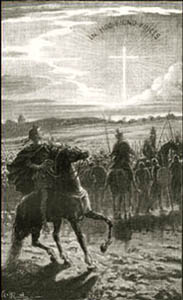
Constantine –
The surrender of Verona was the consequence. In spite of the overwhelming numbers of his enemy (an estimated 100,000 in Maxentius’ army against 20,000 in Constantine’s army) the emperor confidently marched forward to Rome. A vision had assured him that he should conquer in the sign of the Christ, and his warriors carried Christ’s monogram on their shields, though the majority of them were pagans. The opposing forces met near the bridge over the Tiber called the Milvian Bridge, and here Maxentius’ troops suffered a complete defeat, the tyrant himself losing his life in the Tiber (28 October, 312). ….
If mankind ever needed a sign from God blessing the spread of Christianity, and the Gospel, they were given one on May 7th of 351. Shortly after Cyril had been installed as Archbishop of Jerusalem on the day of Pentecost, a luminous cross appeared in the sky over Jerusalem. “About nine in the morning, a vast luminous body, in the form of a cross, appeared in the heavens, just over the holy Golgotha, reaching as far as the holy Mount of Olivet (about two miles). This was not seen by one or two persons only, but by the whole city, and it continued for several hours, the light from it being more brilliant than that of the sun.” The sign in the sky was a miracle for all to see. It drove Jews, Pagans and Christians alike to churches in praise of Jesus Christ. The luminous cross over Jerusalem was taken as sign by those at the time of God’s approval of the spreading Gospel and expanding Christendom. As St Cyril wrote in his letter to Emperor Constantine, the cross in the sky was “being seen not by one or two only, but manifest with perfect clarity to the whole multitude of the city; not, as one might suppose, rushing swiftly past in fancy, but seen openly above the earth many hours in plain sight, and overcoming the beams of the sun with its dazzling rays.” “The whole city found in this phenomenon the truth of Christian doctrine, to which the heavens bore visible witness.”
“So swiftly runs the word of God that though in several thousand years God was not known except among the Jews, now within the space of a few years, His word is concealed neither from the Indians in the East nor from the Britain’s in the West.”
— Arnobius of Sicca (284-
Rebuilding of the Temple - 331-363 AD
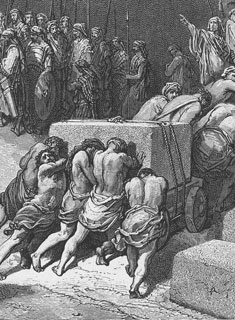
Such were the bishop’s words: and on the night following, a mighty earthquake tore up the stones of the old foundations of the temple and dispersed them all together with the adjacent edifices. Terror consequently possessed the Jews on account of the event; and the report of it brought many to the spot who resided at a great distance: when therefore a vast multitude was assembled, another prodigy took place. Fire came down from heaven and consumed all the builders’ tools: so that the flames were seen preying upon mallets, irons to smooth and polish stones, saws, hatchets, adzes, in short all the various implements which the workmen had procured as necessary for the undertaking; and the fire continued burning among these for a whole day. The Jews indeed were in the greatest possible alarm, and unwillingly confessed Christ, calling him God: yet they did not do his will; but influenced by inveterate prepossessions they still clung to Judaism. Even a third miracle which afterwards happened failed to lead them to a belief of the truth. For the next night luminous impressions of a cross appeared imprinted on their garments, which at daybreak they in vain attempted to rub or wash out ..
The Blood Miracle of Saint Januarius (Gennaro) 305 AD- A miracle of the Church that is still occurring today
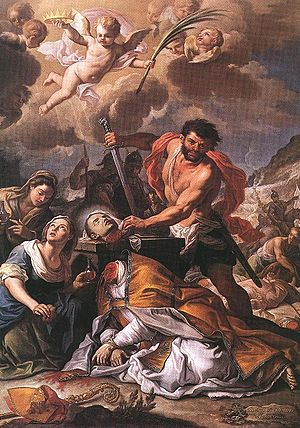
The liquefaction (becoming liquid) of the blood of St Januarius (Gennaro) is an extraordinary miracle of the Church that has been occurring up to 18 times each year for the past 600 years. It is only one of a number of blood miracles that have taken place, and in the case of St Januarius-
Cross in the Sky over Jerusalem - 351 AD
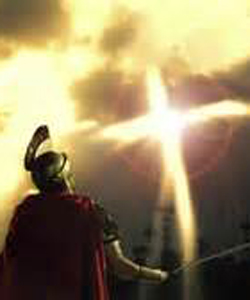
St. Cyril wrote a letter known today as the Letter to the Emperor Constantius, the son of Constantine the Great, describing the miracle in vivid detail and making it clear that the miracle was a sign from God. The letter reads:
“On the nones [or 7th] of May, about the Terce hour [or nine in the morning], a vast luminous body, in the form of a Cross, appeared in the sky just over the holy Golgotha, reaching as far as the holy Mount of Olives, seen not only by one or two persons, but clearly and evidently by the whole city. This was not, as may be thought, a momentary transient phenomenon: for it continued several hours visible to our eyes, and brighter than the sun, the light of which would have eclipsed it, had not this been stronger.
“The whole city, struck with a reverential fear tempered with joy, ran immediately to the church, young and old, Christians and heathens, citizens and strangers, all with one voice giving praise to our Lord Jesus Christ, the only Son of God, the worker of miracles; finding by experience the truth of the Christian doctrine, to which Heaven bears witness.”
Saint Patrick - ~389 AD– 461 AD

Saint Patrick was born in Britain around 389 A.D. At the age of 16 was playing with friends near the sea shore was taken into captured by barbarian and sold into slavery in Ireland. For six years through the snow, frost and rain Patrick herded sheep for a Druid chieftain. He prayed to God every day. In his sleep he heard God’s say to him “It is well that you fast, soon you will go to your own country.” A while later heard “See, your ship is ready … Patrick wrote he took flight and God way till he made it to the ship.
At the age of forty he went back to Ireland as a missionary. Divine message “two months you shall be with them.” “I saw a man coming, as it were from Ireland. His name was Victorious” — he carried many letters … the heading: ‘The Voice of the Irish’. … Patrick wrote he imagined he heard the voice of the people of entire country cry out in one voice: “We appeal to you, holy servant boy, to come and walk among us.”
- God protected Patrick from Druids who hated him and wanted him killed.
- Saint Patrick performed a thousand miracles from rising of the dead, healing the blind, the deaf, leprosy and other diseases. In less than 30 years he consecrated 350 bishops, erected 700 churches, and ordained 5,000 priests. He overturned the pagan religion of the druids with the greater part of Ireland Catholic.
“I shall not be silent; nor shall I hide the signs and wonders which the Lord has shown me many years before they came to pass, as He knows everything even before the times of the world.”
Clovis I - King of the Franks - 466 AD - 511 AD
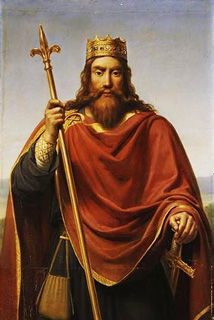
Clovis was born in 466 A.D. in the north east of present day France around Calis. At the age of fifteen seceded his father [Childeric I] as King of the Salian [Sale en] Franks. Surrounded by a number of warring barbarian kingdoms, Clovis used their limited military might winning many battles which increased the territory under their control including overthrowing the last Roman military commander in Gaul.
After losing two battles to the Visigoth forces near Bordeaux in A.D. 490, Clovis arrived at Tours and visited Saint Martin’s parish on his feast day. Saint Martin was a solder in the Roman Army that became a monk.
At Saint Martin’s parish it is said Clovis prayed and witnessed several miracles and may have had a religious experience. In 493 he married a Catholic Burgundian princess Clotilde [KLowTIY-LD]. She had little success in convincing him to convert to Christianity.
In 496 he came to the assistance of the Franks of the Rhine at Battle at the Battle of Tolbiac, near modern day Cologne, Germany. They were losing the battle when he begged his wife’s God for help. He committed that if they were victorious he would convert to Catholicism and be baptized. “If thou wilt grant me a victory over the foes” he cried “I will believe in thee, and will be baptized in thy.” The battle soon turned and the Franks were victorious.
After months of reflection on promise he made to God for assistance he converted to Catholicism. On December 25, 496 the Clovis I, King to of the Franks along with 3,000 fellow warriors were baptized to the Catholic faith. To follow would be the conversion of the entire Frankish people. His conquests continued invading and conquering the Visigoths Southern Southwestern part of modern French liberating the the Catholics living there.
Just before his death Clovis convened a council of bishops at the Council of Orleans in 511. It condemned the Arian Heresy spread that denied the Trinity and divinity of Jesus Christ. It created a strong link between the crown and the Catholic Church.
First Millennium - Second 500 years
Miracle of Lanciano - Eucharistic Miracle ~700 AD

Around the year 700 in the Monastery of St. Longinus (the Roman soldier who pierced the side of Christ with a lance), a priest-monk of the Order of St. Basil was celebrating the Sacramentary of St. Gregory the Great (dating from around 600 A.D.), a Mass very close to our present Tridentine Mass. Having suffered recurring doubts about Transubstantiation, he had just spoken the solemn words of Consecration when the host was suddenly changed into a circle of Flesh and the wine transformed into visible Blood. Weeping joyously, he hastened to call the other monks to witness this stupendous miracle.
The Flesh remained intact, but the Blood in the chalice soon divided into five pellets, reminding one of the five wounds of Christ of unequal size and irregular shape. The monks decided to weigh the pellets. It was discovered that the combined weight of the five clots of Blood was equal to the individual weight of any one of them, a miraculous confirmation of the Church teaching that Our Lord is as equally present in the smallest piece of the Host as the whole Host. (from website Tradition in Action)

That same Host made Flesh remains intact until this date, and today it is enclosed in a monstrance of finely sculptured silver and crystal. The globules of Blood are held in a chalice of etched crystal thought to be the original where the miraculous change occurred.
Through the centuries there have been a number of careful authentications. In 1970 the most detailed scientific investigation was carried out by noted scientists in many different fields (hematologists, anatomists, pathologists, histologists, biochemists, etc.), and led by the renowned Italian Doctor and Professor Odoardo Linoli.
On examining the monstrance, it was observed that the lunette containing the Flesh was not hermetically sealed; that is to say, even though it had been exposed to atmospheric and biological agents, it had not decomposed since the year 700. It was also found that the center of the Sacred Host – the only part that remained bread – had entirely decayed. The five pellets of Blood had not changed in appearance over the centuries and were incorrupt. (from website Tradition in Action)
Battle of Covadonga - Our Lady of Covadonga - 722 AD
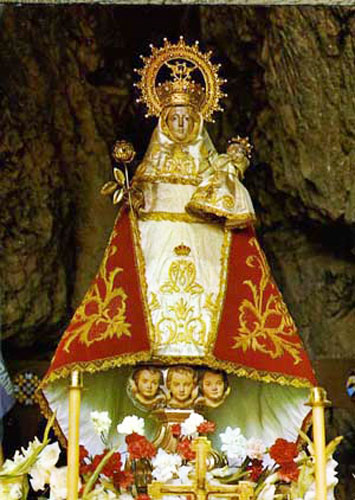
he Moors began the attack, sending arrows at the Catholic soldiers behind the stone cliffs. But already, at this first attack, something extraordinary happened: the arrows returned against the Moorish archers who had drawn the bows, killing them. A group of Catholics advanced to fight, while others shot arrows and threw stones and trunks from the Alzeba Mountain down over the enemy troops.
After a short while, Suleiman, the second in command, fell dead, disorder erupted in the army, and Alkamar gave the order to retreat.
At that moment a terrible storm broke out. Thunder roared, lightning lit the dark slopes, and heavy rain caused mudslides that sent boulders and trees tumbling down the mountain and falling over the retreating Arab troops. Struggling in the mud, many Moorish soldiers slipped and fell into the Deva River, where they drowned. The Holy Virgin made the mountain itself fall over the soldiers of Muhammad.
The battle of Covadonga was won, and Pelayo was proclaimed King of the Austurias. In recognition of the miraculous intercession of Our Lady …
St James the Great in the Battle of Clavijo - 844 AD
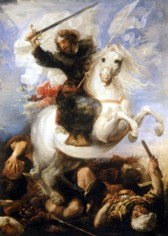
I was still sleeping, when the blessed Santiago, protector of the Spaniards, appeared to me. I asked who he was. He assured me to be Santiago, the blessed Apostle of God. Astonished as I was, the blessed Apostle told me: Did not you know that my Lord Jesus Christ, while distributing the other provinces in the world to my brothers, the other apostles, luckily entrusted me the guardianship of all Spain and placed it under my protection? (…) Keep your courage, because I will come to assist you tomorrow, God willing, to vanquish all that big crowd of enemies surrounding you. However, many of your soldiers will be destined for eternal rest and will receive the crown of martyrdom during your struggle for the name of Christ. And so that there is no doubt you will see me dressed in white on a white horse, holding in my hand a white banner. Therefore, at dawn, after receiving the sacrament of penance with the confession of sins, after receiving the Communion of the Body and Blood of the Lord in the Mass, do not be afraid to challenge the Saracens’ squadrons, invoking God’s name and mine, and taking for certain they will fall to the edge of the sword .
Having said all that, the pleasant vision of the Apostle of God disappeared.
Ramiro quickly told everyone about his vision: knights, bishops, artisans … At dawn, Christian troops, sure of their victory, attacked the Saracens. For the first time some Spaniards used “Santiago” as a war cry. In the heat of the battle, a great white knight, with a white banner on a white horse, struck the field like a ray of light, to tilt the victory on the crusaders’ side. On May 25, in the town of Calahorra, the king vowed to Santiago in gratitude, inviting all Christians in the peninsula to go on a pilgrimage to Santiago de Compostela, carrying offerings to the Apostle.
The Stone of Destiny, Scotland - ~840 AD
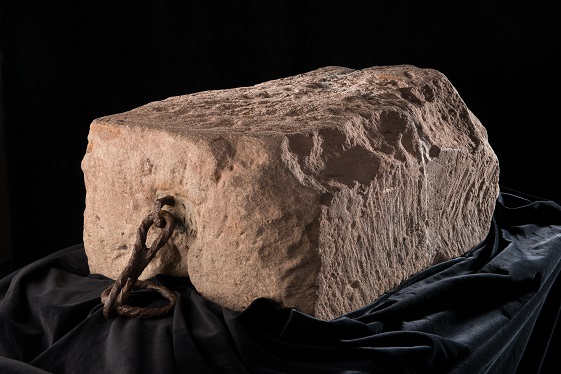
The Celtic name of the stone upon which the true kings of Scotland have traditionally been crowned is Lia Fail, “the speaking stone”, or the stone which would proclaim the chosen king.
It was originally used as part of the crowning ceremonies of the Scots kings of Dalriada, in the west of Scotland, an area just north of Glasgow now called Argyll.
When Kenneth I, the 36th King of Dalriada united the Scots and Pictish kingdoms and moved his capital to Scone from western Scotland around 840AD, the Stone of Destiny was moved there too. All future Scottish kings would henceforth be enthroned on the Stone of Destiny atop Moot Hill at Scone Palace in Perthshire.
The stone in question is no ornately carved megalith, just a simple oblong block of red sandstone, measuring some 650mm in length by 400mm wide, and 27mm deep: with chisel marks apparent on its flat top. …
Note: Luke Harding interview of Charle Champ – Prophetic Word for America and the World in 2022 – January 19, 2022
“I know you’re in Edinburgh, there is something in particular very powerful that is going to transpire in this decade. In edinburgh is going to be going to be highlighted and you know the destiny stone that’s in Edinburgh. I saw that stone being moved I saw it being brought back in into the into the UK. I mean into England. And um when that happens there’s going to be a a very powerful shift that’s going to happen in the in the United Kingdom. But I saw that destiny stone you know this zone, yes some of the viewers in the UK know the stone yeah. It’s connected to the crowning of the Kings and yes, so this decade is there’s going to be. There’s going to be a crowning wow of the King. I love that I’m just going to put it that way so and It’ll be a. It’ll be a crowning of a King but it will be a sign of Christ being crowned over the UK. Amen.”
Virgin of Montserrat - Benedictine Monastery Montserrat in Catalonia, Spain - 890 AD

Our Lady of Montserrat (The Black Madonna of Montserrat) – Due to Muslim invasions of Spain that began in the 8th century, the statue was taken to Montserrat and hidden in a cave in 718. In 880, some shepherd children were tending their flocks when they saw a brilliant light coming from the cave, accompanied by sweet music. They went there and found the Statue. They reported it to their Bishop, who recognized the supernatural origin of the finding and prodigies that followed. They tried to move the statue from the cave, but it was so heavy that it could not be budged. They interpreted this as Our Lady’s desire to stay there, so a monastery was constructed around it.
Many miracles have been attributed to the Virgin of Montserrat, and it soon became a great pilgrimage site. The devotion spread to Latin America. (from Tradition in Action.)
King Alfred the Great - 849 AD – 899 AD

The Anglo-Saxons were in a life and death struggle against Danish invaders. … Being the youngest of three brothers and suffering from health issues, it was never expected that he would lead his country’s military. However, things changed after the death of both of his brothers and as a result Alfred was crowned King of Wessex.
He separated Wessex into multiple military districts for better defense. Despite larger Danish forces, at times taking the offensive they were successful in to pushing back the invaders. Then through a peace treaty, Alfred was able to convert one of the key Viking leaders over to Christianity and civilization on the island advanced.
Alfred promoted learning and literacy among the people. But most importantly, he adopted the Mosaic and apostolic law. Alfred imposed these laws not only on the citizens in his Kingdom, but also on the kingdom’s leaders as well. Under these laws literacy and national defense increased, and the kingdom grew strong. The following is an excerpt the legal code of laws and judgements of King Alfred written in 893 A.D., titled Doom Book.
These are judgments which Almighty God Himself spoke to Moses and commanded him to keep. Now, since the Lord’s only begotten Son our God and healing Christ has come to Middle Earth [the Mediterranean World] He said that He did not come to break nor to forbid these commandments but to approve them well, and to teach them with all mildheartedness and lowlymindedness.
— King Alfred the Great (849-899) King of Wessex